Scientists show small earthquakes caused by fracking near Guy-Greenbrier, Ark., in 2010 that could have been early indicators of high stress levels on larger faults deeper underground.
Arkansas
Posted inResearch Spotlights
Reimagining a Fatal Flood
Researchers use high-resolution simulations to reexamine the rainfall events that led to one of the most destructive floods in U.S. history.


